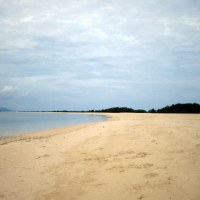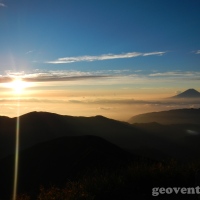Puerto Princesa — one of the cleanest and greenest cities in the Philippines, dubbed as The City in a Forest. It is home to the famous Underground River, to the beautiful islands of Honda Bay, and to a lot of other unique and wonderful sights. And of course, let’s not forget it’s my home town 😉
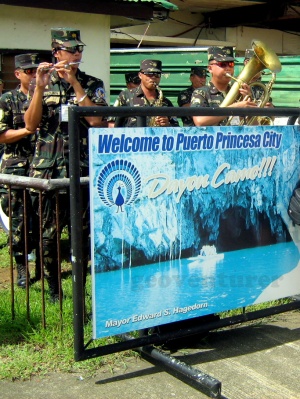
It’s a famous tourist destination among locals and foreigners alike. The only problem is that visiting the sights can sometimes get too costly. (Don’t get me wrong, I’m all for supporting the thriving tourism industry in Puerto Princesa. If you like to relax and travel in comfort, please visit this site for a list of travel agents (or you can contact Mars of Travel Portal Duo at +639166151856). Although the prices for the tour packages are reasonable and the tours are more comfortable and hassle-free, a cheaper alternative is to do it the backpacker way. Of course this means roughing it out! I will give an ideal itinerary for visiting the famous tourist destinations and try to give some advice (based on personal experience from bringing visitors to the tourist sites) on how to save by doing the tours on your own.
First, let’s get you there. Major local airlines such as PAL Express, Cebu Pacific, and Air Asia each fly to Puerto Princesa several times a day from Manila. There are also some flights from Cebu.
Next, you should book your hotel or pension or resort, whichever is right for your budget and needs. You can choose where you want to stay on this site. My suggested hotels/pension houses would be: Liane’s Place (nice native theme, reasonable price and most convenient location in the city center just in front of the Provincial Capitol) or Tenzai Pension House +63484330189 (cozy place, reasonable price with airport transfer and free breakfast). If you need help with booking for accommodations in other hotels/inns, Jeffany (licensed city tour coordinator) can help you pick out the ideal accommodation for your budget, at no extra cost to you 🙂 (Contact her at +639272864350 or email her at belvone14@gmail.com).
How long should you stay in Puerto Princesa? Well, you of course want to make the most of your time there, so I would say you need at least three full days (on a tight schedule), but four days would be just right. Below is an ideal itinerary, including the comparison of getting the tour package and “doing-it-yourself”:
Day 1- City Tour
It is better to have a morning flight so you have more time for touring the city.
> If you got the City Tour Package from a travel agent, you will be toured using an aircon van with a licensed tour guide. Your destinations more or less include: Crocodile Farm, Iwahig Prison and Penal Farm, Binuatan Creations, Rancho Sta. Monica, Butterfly Garden, Baywalk, Plaza Cuartel and Cathedral. City Tour Package: Php 600/person
> However, you can also opt to do the tour by yourself. There are several ways of doing this, depending on how many you are in the group. If you are in a group of two to four, you can hire a tricycle (serves as the taxi in the city, only it’s three-wheeled) for half the day for Php 400 to 700 (I recently met this hardworking tricycle driver when I toured my friend – contact him directly to inquire: Regel Villegas +639105811183) . If you are in a group of five to ten, you can hire a multicab for 800 to 1,000, depending on your bargaining powers (multicabs are like small jeepneys that accommodate 10-12 persons). If you are in a group of ten or more, renting a van with driver is a better option (Php 1000-1500, refer to the link of tour companies, they also offer van rental services, or contact IC of Isee Palawan Travel & Tour Services at +639178859494 / +639098849494.)
If you are adventurous enough and are not afraid to get lost, you can also rent a motorcycle and roam around by yourself. Rates are at Php 50 per hour or Php 500 per day. The motorbikes for rent are just beside the airport exit gate. If you prefer self-drive car rental services, please contact Plong Car Rental at +639175530889 or 09197260367.
If you are alone or in a group of 2, you can choose to use public transport, the DIY Price is Php~200/person for combined tricycle/multicab fares. Here is my suggested route:
– Binuatan Creations: If your hotel is in the city proper, take a tricycle (Php 8 per person within the city proper) to Rizal Avenue, preferably at Jollibee and ride the multicab with the route “Pajara-Sta. Monica-Bunkhouse”. It is better to sit near the driver so you can tell him to drop you off at PPSAT (Puerto Princesa School of Arts and Trade), at the road to Employees Village (fare Php 12 to 15 . From there, you can walk to Binuatan Creations (it is a bit far, though, about a block or two from the main road), or if you have Php 8 to spare you can ride a tricycle. Don’t be afraid to ask for directions if you are unsure 🙂

(photo from their website)
Binuatan Creations is a place where you can experience making handloom woven mats using indigenous plant fibers. Their products are world-class exports and you can buy these native products at the source. You can click here for their contact information.
– Palawan Butterfly Ecological Garden and Tribal Village. After the handicrafts, you can return to the main highway (walk or take the tricycle) where you were first dropped off. From there, take the multicab with the same route “Pajara-Sta. Monica-Bunkhouse” and tell the driver to drop you off at Butterfly Garden (fare Php 8; Entrance fee Php 50, Php 35 if you have any valid Philippine ID).
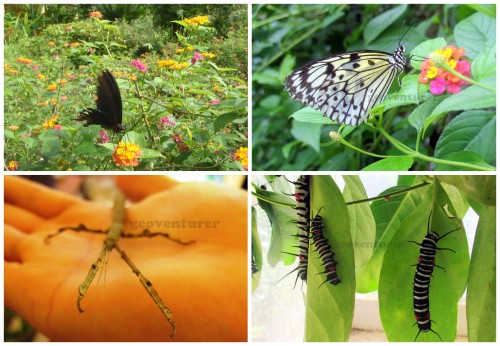
Butterfly Garden is a place where you can observe and interact with different species of butterflies as well as flowering plants. If you are lucky, you can see butterflies emerging from their pupae (yey!). Aside from butterflies, they also have a small collection of insects and reptiles. Recently they added a tribal village to their attractions showcasing the culture of the Palau’an, an indigenous group in the province.

From pupae to butterflies. Watch the magic unfold at the Butterfly Garden!
– Baker’s Hill. After butterfly garden, you can walk to the main highway (about 100 meters away) and ride the tricycles idling there to Baker’s Hill (fare is Php 10 per person or Php 20 if they take you there alone; Free entrance).

Baker’s Hill is a bakery/restaurant with a very nice mini park. You can have some snacks while enjoying the landscape. It is a pretty famous dating spot for locals 😉 The bakery’s specialties are the Hopia Ube and Hopia Baboy.
– Mitra Ranch. You can climb to this next destination if you are up for it, but tricycles are waiting just outside Baker’s Hill to take you to the Rancho (fare Php 8 to Php 10; Free entrance).
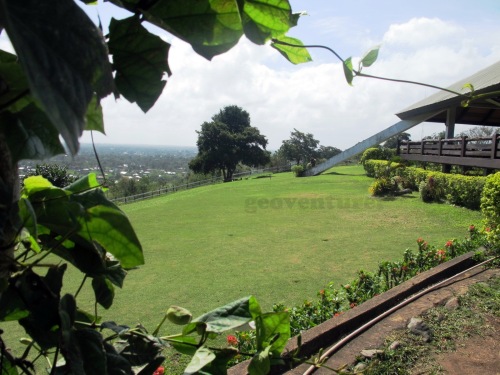
The Ranch is owned by the former governor of Palawan, and provides a nice view of the city. Recently, they added the Rancho Zipline, which costs Php 500 for 3 lines and boasts of a 360-degree flip at the end.
– Crocodile Farm (aka Palawan Wildlife Rescue and Conservation Center). You can walk back to the main highway or take a tricycle (Php 10). On the main highway, take a multicab with the route “Irawan”, and tell the driver to bring you to Crocodile Farm (fare Php 10 to 12; Entrance fee Php 40).
The crocodile farm has, of course, lots of crocodiles! You can even have your photo taken while holding a live baby crocodile. They also have a park which feature Palawan’s endemic species such as the Palawan Bear Cat, bearded pig, mynah and other exotic animals.
– Palawan Heritage Center. This museum can be found at the back end of the Legislative Building of the Palawan Provincial Capitol. (Just tell your vehicle to drop you off there.) The center is fairly new, and boasts of a nice collection of artifacts depicting Palawan’s history with a special focus on the indigenous people of Palawan. Pretty neat place! They are open during office hours. Entrance fee costs 40Php for adults and 20 Php for students.
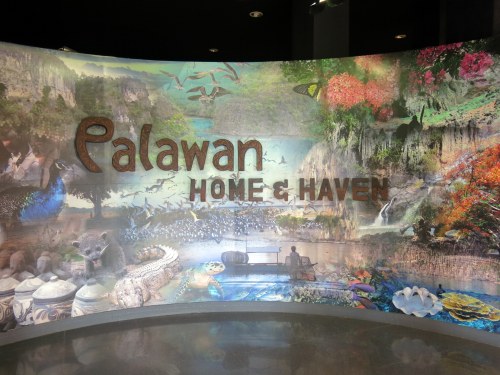
At the entrance of the Palawan Heritage Center
– Plaza Cuartel – Cathedral – Baywalk. From the crocodile farm, you can take a multicab back to the city (Fare Php 18 to 20). Tell the driver to bring you to the Cathedral (it is usually the end of their route).
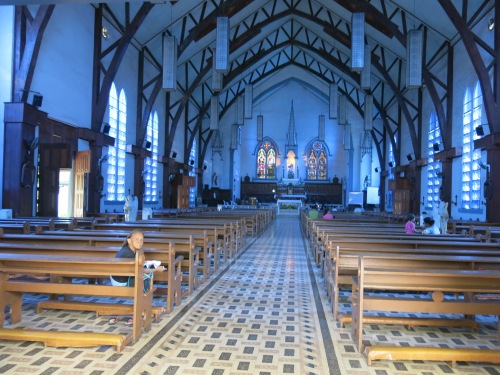
Immaculate Conception Cathedral
*You can also visit this last part after the Underground River or Honda Bay Tour, it is within the city and the fare only costs Php 8 by tricycle if you come from anywhere in the city proper.
The Plaza Cuartel is very near the cathedral’s main entrance. It used to be known as “Lover’s Park” for local teenagers (during my teen years, anyway). It used to be a Japanese garrison during WWII, and is now a memorial park for war victims. From the Cathedral, you can take a tricycle to Baywalk (Php 8) or walk the 3-4 blocks if you still have the energy. The Baywalk is now a popular place to stroll, bike (available for rent), and to try street food while enjoying the view of Puerto Princesa Bay.

The peacock is the symbol of Puerto Princesa, and is incorporated in the design of the Baywalk
Optional destinations (i.e. not part of the DIY Price computation):
– Iwahig Firefly Watching. This is an option if you still have the energy (and money) in the early evening. Or do this after the island hopping or the Underground River Tour the next day. You can hire a tricycle or multicab to take you to Iwahig and wait for you until you finish (about Php 300-600 for a tricycle OR you can include this in your itinerary if you hired a vehicle for the day and prepare to add a small amount to the quoted fees above). A small boat for 2-4 persons costs Php 600, and a guide will row the boat for you. Remember to bring some snacks since you will have to spend until dinnertime in Iwahig.
DIY Price: Php 600/2-4 persons + vehicle rental
Firefly Watching Tour Package: Php 1,100 (includes van transfers, shed rental, boat rental, tour guide, DINNER at the site)
– Sta. Lourdes Hot Spring. If you have more time to spare, you can spend an hour or two relaxing in the hot spring pools in Sta. Lourdes. The place is out of the way from most of the destinations I indicated above, and is much closer to Honda Bay and along the way to the Underground River. But if you have the means (hired vehicle), soaking in the hot water pools can also be a good way to relax. The rental is on a per pool basis. Rates vary from Php 350-1000 per pool, depending on size and on how fancy the resort is (the hot spring resorts are just beside each other).
Day 2 – Underground River (I have a separate blog post on this, just click on this link)
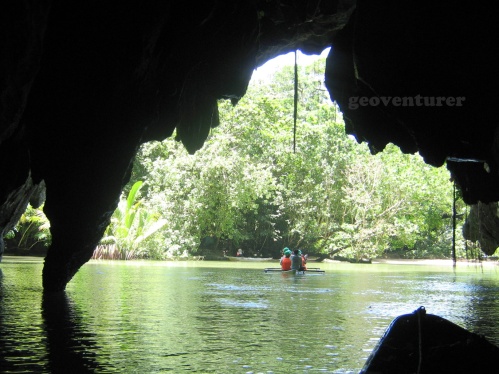
> Tour Package: Php1,500/person (details on this blog entry)
> DIY Price: Php750-900/person (details on the blog entry mentioned above)
Day 3 – Honda Bay Island Hopping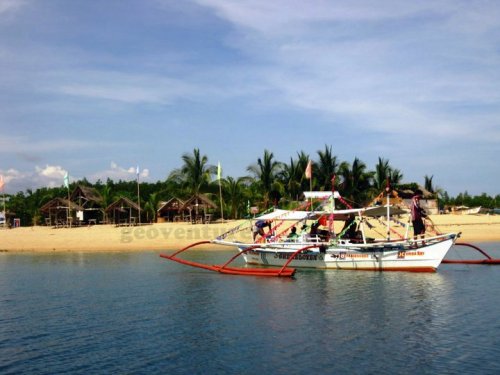
> Tour Package: Php 1,400/person including airconditioned van transfer, licensed tour guide, picnic lunch, entrance fees, environmental fee
*If you came alone or as a couple, it might be better to avail of the tour package (as you will see when I discuss the commute option) (refer to my list of tour coordinators above for contacts).
> Doing it yourself:
First things first. You need to be prepared for the tour. (Note: Cutoff time for boat hire is at 2:00 pm, so make sure you are at the Honda Bay well before that time).
1. Buy lunch/snacks at the city proper if you want to save on food costs (They offer fresh seafoods that they can cook for you at Snake Island *about Php 150-500* but other islands don’t have much to offer).
2. If you have a snorkel set, you can save Php 100 since this is the cost of rental (but it’s a must to enjoy the amazing beauty under the sea).
Then, you need to get to Honda Bay, which is a thirty- to forty-minute ride from the city proper. There are a few multicabs that ply the “City Proper-Honda Bay Sta. Lourdes” route (fare Php 20 to 25), but then you might have a problem getting a ride back to the city afterwards. If there are no multicabs or tricycles waiting, you need to walk about 1.5 kilometers to the main highway and try your luck getting a tricycle or van to take you to the city (chances are slim, though).
A better solution is to hire a tricycle (for 2 to 5 persons; Php 300 to 500) or a multicab (for 6 to 10 persons; Php 1000 or more) for round trip service that will take you to Honda Bay AND return for you in the afternoon to bring you back to the city.
When you arrive in Honda Bay, proceed to the Tourist Information Office and rent a boat. The rates are standard: Php 1300 or Php 1600 (the rate depends on the motor power) for one motorized boat good for 6 persons, plus Php 220 for any additional person. You also need to pay the terminal fee, which is just Php 18 per person and the environmental fee for Php 40. Note that you can share the boat with other tourists, if you find shoestring travelers like you in small groups also looking to rent a boat. It’s a good way to make new friends!
Oh, and buy lots of stale bread before you go off to the islands. It’s really fun to feed the fishies!
You can have your pick of the islands to visit, and each island has their corresponding entrance fee (ranging from 25 to 100 Php) that you can check out when you get there.
Personally, I recommend:
– Snake Island (free entrance; cottage rental Php 50; currently closed) – The island boasts of a long stretch of white sand. It is named after its long snakelike shape.

Strolling the long stretch of white sand with the resident island dog
A sari-sari store in the island sells snacks, drinks, fresh buko juice, and fresh seafood that they can cook for your lunch (Php ~150-500). But the best part of this island is underwater. There are literally A LOT of fishes in this sea 😉 You can feed them bread (which you can buy at the port where you paid for your boat rental) so they will swarm around you.

– Starfish Island (entrance Php 50) – As the name implies, there are a lot of starfishes!

But more than that, the best part of this island is also underwater. You can ask your boatman to take you snorkeling near the shore.
– Pambato Reef (Php 50 for snorkelers) – This is just a floating hut in the middle of the sea, but the coral formations there are the best in Honda Bay and even in Puerto Princesa. One tip: the waves are stronger in the afternoon so it is better to visit Pambato Reef early. Just ask your boatmen for their advice.
Other islands that you can visit include Pandan Island, Lu-li (lulubog-lilitaw) Island, and Cowrie Island.
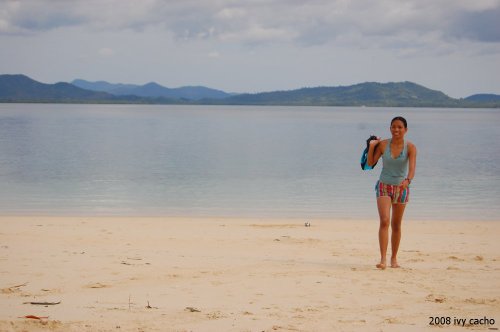
DIY Price: Php 1800 for 4-5 persons + 200/person for entrance fees (lunch not included)
Day 4 – Dolphin Watching (my blog post about this experience can be found here)
This tour is ideal on the day of an afternoon return flight, as the tour is usually done before 11 am.
Excerpt from the blog: If you want to see the spinner dolphins swim, play and do somersaults, just show up at the Baywalk of Puerto Princesa at around 6 am and look for the boats along the bay (we paid Php 700/person at that time). However, this method might not be reliable as you cannot be guaranteed a space in the boat if you did not talk to them ahead of time, so it might be better to contact a travel agency (Tour Package rate: Php 900/person).
There you go! I hope the information above can help you enjoy Puerto Princesa, whether you choose to avail of the tour packages or to tour around on your own. Have a great time!
P.S. I am also including a list of my recommended restaurants in the city. To reach these restaurants, just take a tricycle from anywhere in the city center (Php 8 per person) and tell them the restaurant name. Prices quoted are estimated on a per person basis.
> Ka Lui (Rizal Ave) – offers delicious Filipino food with a very “native” ambience. It is a bit pricey, but the food is really good. (Php 250-500)
> Chicken Inato (Manalo St) – their specialty is chicken barbeque that is very, very tasty (Php 100-200)
> Balinsasayaw (Rizal Ave) – this restaurant also offers chicken barbeque as their specialty, but they have a variety of Filipino dishes as well (Php 60-300)
> Neva’s Place (Taft St, beside Children’s Park) – This is a pizza and pasta place with very great ambience and good food (Php 70-250)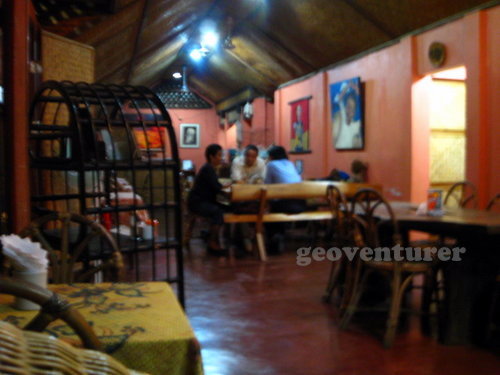
> Bona’s Chaolongan – Vietnamese dishes are very popular in Puerto Princesa from when the Vietnamese refugees came to Palawan. This restaurant has been a favorite for local students because of the price AND the taste. (Try the beef stew noodle with garlic french bread!) BUT if you are particular about ambience, I suggest you go to a fancier Vietnamese restaurant (Price Range 50-100)
> Rene’s Saigon – This place is the “fancier” Vietnamese restaurant, and also serves good food. *This place is a little far from the city center, farther than the airport so the fare is a peso or two higher.

Yum yum!
> Rustic Avenue (Rizal Avenue in Dagomboy Village) – It’s a newly opened restaurant that serves Pinoy food (but their signature dish is the honey garlic chicken) and some cakes and pastries. It’s a cozy little place for a quiet lunch or dinner and a drink or two in the evening (Price Range 50-135)
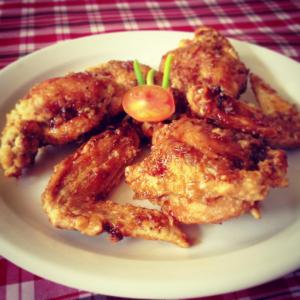
Rustic Avenue’s Honey Garlic Chicken
> Kinabuch’s (Rizal Avenue, near Capitol)- This is more of a dinner/after-dinner place where you can chill and have a beer while trying Palawan’s exotic dishes such as tamilok(mangrove worm) or crocodile meat.

Tamilok (worm from mangroves). Best eaten fresh, and with beer 🙂
> Kamarikutan Kape at Galeri – This is a coffee shop with a very nice ambience.
> Itoy’s Coffee Haus – The more popular coffee place since it is located in the city center
>> There are also fast food establishments like Jollibee, Chow King, Shakey’s for on-the-go meals. Farther from the city center is the newly-opened Robinson’s Mall in Baranggay San Manuel, so there’s now a great number of franchised restaurant food choices (although I still recommend our local restaurants for that unique Puerto Princesa experience).
Just don’t forget to try chao long, french bread, tamilok and croc meat and of course, lots and lots of fresh seafood!
***Oh, and the souvenirs! The cheapest souvenirs can be bought in the LRC Pasalubong Center in San Miguel, almost across Mercado de San Miguel (ask the tricycle drivers to bring you there). Typical food souvenirs include cashew, dried fish/squid/tahong, spicy dilis, hopia (from Baker’s Hill). For souvenirs that last longer, you can buy the rainmaker, cultured pearls, and assorted knick knacks of native products.
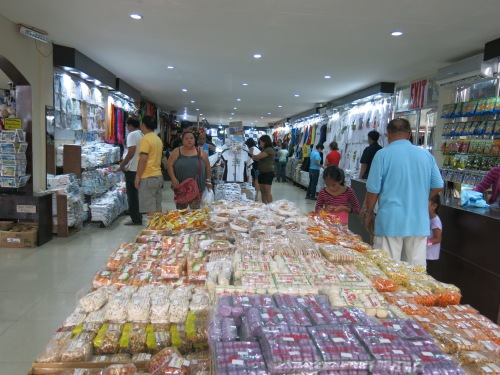
LRC Pasalubong Center – They offer the most diverse options and the cheapest prices of souvenir items








































































































